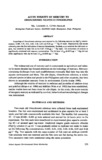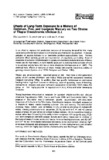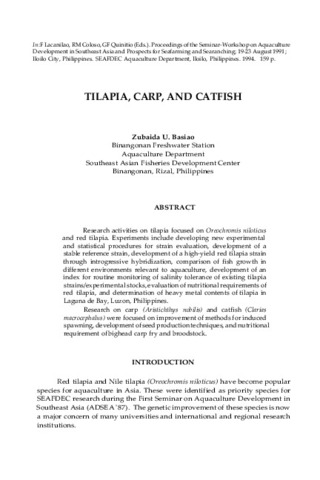Resistance to heavy metal mixture in Oreochromis niloticus progenies of parents chronically exposed to the same metals
- Global styles
- MLA
- Vancouver
- Elsevier - Harvard
- APA
- Help

View/
Date
1995Page views
1,370ASFA keyword
AGROVOC keyword
Taxonomic term
Metadata
Show full item record
Share
Abstract
Our inland waters continue to suffer from pollution. This has resulted in prolonged exposure of fish and other organisms to pollutants. This study was carried out to determine some of the possible long-term effects of exposure to heavy metals in the Nile tilapia, Oreochromis niloticus.
One month old 0. nifoticus fingerlings were exposed for 2 months to a mixture of 0.01 mg per 1 Hg, 0.1 mg per 1 Cd and 1.0 mg per 1 Zn. The survivors were grown to sexual maturity in a natural environment (lake) then spawned. Results showed that the exposed 0. niloticus can recover from the prolonged exposure to the metals as demonstrated by their spawning success and fry survival which was comparable to the unexposed group. This could be because the accumulated heavy metals were eliminated by the fish during the lake grow-out phase. By the time the fish were spawned, they have eliminated the 85 to 98% of the heavy metals from their body.
The progenies of the exposed parents (EP) were subsequently exposed to another mixture of the three metals: 3.0 mg per 1 Zn, 0.30 mg per 1 Cd and 0.01 mg per 1 Hg, in both static and static-renewal system. Another group from unexposed parents( UP) received the same treatment. Results showed that in both exposure systems, the survival of the progeny of EP was significantly higher (P < 0.05) than the those from UP. Survival was three to five times better in the progenies of EP than those of UP. Exposure of the parental stock resulted in the culling out of individuals which were more susceptible to the heavy metals. The more resistant members of the population (the survivors) which have the ability to adapt to the toxicants were able to pass on the resistance to their offspring. The results are supported by other studies which demonstrate high resistance in populations of organisms living in contaminated sites.
Subjects
Nile tilapiaDescription
Abstract only.
Suggested Citation
Cuvin-Aralar, M. L., & Aralar, E. V. (1995). Resistance to heavy metal mixture in Oreochromis niloticus progenies of parents chronically exposed to the same metals. Aquaculture , 137(1-4), 276. https://doi.org/10.1016/0044-8486(96)83570-8
Type
ArticleISSN
0044-8486Collections
- Journal Articles [1258]
Related items
Showing items related by title, author, creator and subject.
-
Acute toxicity of mercury to Oreochromis niloticus fingerlings
Cuvin-Aralar, Ma. Lourdes A. (SEAMEO BIOTROP, 1991)Fingerlings of Oreochromis niloticus were exposed to the following mercury (as HgCl2) concentrations: 0.005, 0.01, 0.02, 0.03, 0.04, 0.05 and 0.06 mg l-1 Hg of water. Hyperactivity and erratic swimming ... -
Effects of long-term exposure to a mixture of cadmium, zinc, and inorganic mercury on two strains of tilapia Oreochromis niloticus (L.)
Cuvin-Aralar, Ma. Lourdes A.; Aralar, Emiliano V. (Springer Verlag, 1993)Tilapia are an economically important group of fish. They have a short generation period of 3-6 months, and exhibit successive breeding. In addition, their fast growth, herbivorous or omnivorous feeding habits, high food ... -
Tilapia, carp and catfish
Basiao, Zubaida U. (Aquaculture Department, Southeast Asian Fisheries Development Center, 1994)Research activities on tilapia focused on Oreochromis niloticus and red tilapia. Experiments include developing new experimental and statistical procedures for strain evaluation, development of a stable reference strain, ...






